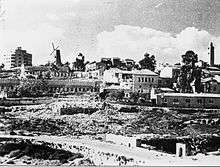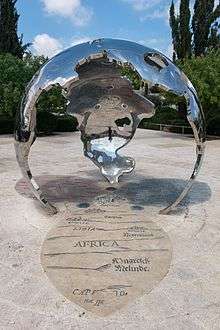Mishkenot Sha'ananim

Mishkenot Sha’ananim (Hebrew: משכנות שאננים, lit. Peaceful Habitation) was the first Jewish neighborhood built outside the walls of the Old City of Jerusalem, on a hill directly across from Mount Zion. It was the first area of Jewish settlement in Jerusalem outside the Old City walls,[1] and was one of the first structures to be built outside the Old City of Jerusalem, the others being Kerem Avraham, the Schneller Orphanage, Bishop Gobat school and the Russian Compound,[2]
History
| Old Yishuv |
|---|
 |
| Key events |
| Key figures |
|
| Economy |
| Philanthropy |
| Communities |
| Synagogues |
| Related articles |
Ottoman era
Mishkenot Sha'anim was built by British Jewish banker and philanthropist Sir Moses Montefiore in 1860 as an almshouse, paid for by the estate of an American Jewish businessman from New Orleans, Judah Touro.[3] Since it was outside the walls and open to Bedouin raids, pillage and general banditry rampant in the region at the time, the Jews were reluctant to move in, even though the housing was luxurious compared to the derelict and overcrowded houses in the Old City.[4] As an incentive, people were even paid to live there, and a stone wall was built around the compound with a heavy door that was locked at night.[5] The name of the neighborhood was taken from Book of Isaiah 32:18: "My people will abide in peaceful habitation, in secure dwellings and in quiet resting places."[3]
Jordanian era

After the 1948 Arab–Israeli War, when the Old City was captured by the Arab Legion, Mishkenot Sha'ananim bordered on no man's land in proximity to the armistice line with the Kingdom of Jordan, and many residents left in the wake of sniper attacks by Jordanian Arab Legionnaires. Only the poorest inhabitants remained, turning the complex into a slum.had left, with Arabs from the surrounding towns and villages (particularly Hebron) buying the homes and land the émigrés left behind.
Restoration after 1967
The no-man's-land bordering Mishkenot Sha'ananim was occupied by Israel during the 1967 War, together with the rest of Eastern and Old Jerusalem.
In 1973, Mishkenot Sha'ananim was turned into an upscale guesthouse for internationally acclaimed authors, artists and musicians visiting Israel.[3] Apart from guesthouse facilities, it is now a convention center and home of the Jerusalem Music Center.[1] The music center was inaugurated by Pablo Casals shortly before his death.[3]
The Jerusalem Center for Ethics was established in Mishkenot Sha’ananim in 1997. The board of directors is headed by Prof. Yitzhak Zamir, a retired justice of the Israeli Supreme Court.[6]
 Etzioni Flame
Etzioni Flame Montefiore Windmill
Montefiore Windmill Ha-Takhana
Ha-Takhana Jerusalem als Zentrum der Welt
Jerusalem als Zentrum der Welt
See also
References
- 1 2 Mishkenot Sha'ananim, jewishvirtuallibrary.org
- ↑ Kark, Ruth; Oren-Nordheim, Michal (2001). Jerusalem and Its Environs: Quarters, Neighborhoods, Villages, 1800-1948. Wayne State University Press. pp. 74; table on p.82–86. ISBN 0-8143-2909-8.
The beginning of construction outside the Jerusalem Old City in the mid-19th century was linked to the changing relations between the Ottoman government and the European powers. After the Crimean War, various rights and privileges were extended to non-Muslims who now enjoyed greater tolerance and more security of life and property. All of this directly influenced the expansion of Jerusalem beyond the city walls. From the mid-1850s to the early 1860s, several new buildings rose outside the walls, among them the mission house of the English consul, James Finn, in what came to be known as Abraham’s Vineyard (Kerem Avraham), the Protestant school built by Bishop Samuel Gobat on Mount Zion; the Russian Compound; the Mishkenot Sha’ananim houses: and the Schneller Orphanage complex. These complexes were all built by foreigners, with funds from abroad, as semi-autonomous compounds encompassed by walls and with gates that were closed at night. Their appearance was European, and they stood out against the Middle-Eastern-style buildings of Palestine.
- 1 2 3 4 Street People, Helga Dudman, Jerusalem Post/Carta, 1982, pp. 21-22
- ↑ Jerusalem architectural history
- ↑ More information about Yemin Moshe
- ↑ Konrad Adenauer Conference Center of Mishkenot Sha'ananim
Photographs
- Jerusalem Photo Archive - Mishkenot Sha’ananim
Coordinates: 31°46′17.05″N 35°13′27.65″E / 31.7714028°N 35.2243472°E
